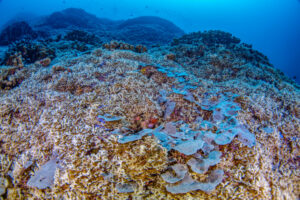Physical Address
23,24,25 & 26, 2nd Floor, Software Technology Park India, Opp: Garware Stadium,MIDC, Chikalthana, Aurangabad, Maharashtra – 431001 India
Physical Address
23,24,25 & 26, 2nd Floor, Software Technology Park India, Opp: Garware Stadium,MIDC, Chikalthana, Aurangabad, Maharashtra – 431001 India

Deep beneath the turquoise waters of the Pacific Ocean lies an extraordinary marvel—a massive coral believed to be thousands of years old, discovered during a National Geographic expedition. This coral, remarkable for its colossal size and ancient lineage, is more than just a wonder of the natural world; it offers critical insights into marine ecosystems and the challenges posed by climate change.
The mega coral was discovered near the Solomon Islands, a region renowned for its rich marine biodiversity and pristine coral reefs. Located in the South Pacific Ocean, the Solomon Islands are part of the Coral Triangle, often referred to as the “Amazon of the Seas” due to its unparalleled marine life. This region is a hotspot for coral ecosystems, hosting over 500 species of corals and thousands of marine species. The discovery of this ancient coral underscores the ecological significance of the Solomon Islands and the vital role they play in global marine conservation efforts. Read here
Unveiling the Ancient Giant
Discovered by National Geographic’s Pristine Seas team, this megastructure is one of the largest and oldest corals ever documented. Stretching over an impressive expanse of reef, its sheer size indicates centuries, if not millennia, of growth. Such discoveries are incredibly rare and underscore the ecological richness of largely unexplored marine territories. Read here
The coral’s age, estimated through its massive skeleton, suggests that it predates modern civilization. This makes it a living archive, potentially offering scientists insights into historical oceanic conditions, including temperature, salinity, and pollution levels over centuries.
Why Is This Discovery So Significant?
Corals like this one are crucial for understanding biodiversity and the resilience of marine ecosystems. According to the National Oceanic and Atmospheric Administration (NOAA), coral reefs support approximately 25% of all marine species, despite covering less than 1% of the ocean floor. Read here
This mega coral serves as a natural laboratory, helping researchers study how ancient reefs adapted to changing conditions. Its resilience offers hope in understanding how marine ecosystems might withstand future climate shifts.
Significant Features of This Coral Ecosystem
This mega coral serves as a living archive of environmental history, offering insights into ancient marine conditions and climate patterns.
Its survival through changing oceanic conditions underscores the adaptability of certain coral species, even in the face of global warming.
National Geographic’s Role in the Discovery
The National Geographic Pristine Seas initiative has been at the forefront of exploring and protecting the ocean’s last wild places. Using state-of-the-art technology, including remotely operated vehicles (ROVs) and deep-sea imaging, the team identified this coral while mapping remote reef ecosystems. Their work continues to emphasize the importance of preserving pristine marine environments, where such natural wonders can thrive.
To learn more about the Pristine Seas project, visit their official site.
Climate Change: A Looming Threat
While this coral stands as a symbol of nature’s resilience, coral ecosystems worldwide are under threat from climate change. Rising ocean temperatures, acidification, and pollution have caused widespread coral bleaching, where corals expel their symbiotic algae, turning ghostly white. According to a recent report by the Intergovernmental Panel on Climate Change (IPCC), coral reefs could face near-total collapse if global temperatures rise by 2°C above pre-industrial levels. Read here
The impacts extend beyond biodiversity. Coral reefs protect coastlines from erosion, support fishing industries, and draw millions of tourists annually. Losing them would be catastrophic for both ecological and economic stability.
A Call to Action
This discovery by National Geographic highlights the importance of protecting marine ecosystems. Efforts like expanding marine protected areas (MPAs), reducing carbon emissions, and sustainable tourism can make a significant difference. Organizations like The Coral Restoration Foundation are working to rehabilitate damaged reefs and preserve genetic diversity for future generations.
Conclusion
The discovery of the ancient coral in the Solomon Islands is a testament to the enduring resilience and biodiversity of coral ecosystems. It serves as a reminder of the interconnectedness of marine life and the critical role coral reefs play in supporting ocean health. National Geographic’s exploration highlights the importance of scientific expeditions in uncovering and preserving these natural wonders. However, the looming threat of climate change underscores the urgency of global action to protect these ecosystems. As guardians of the planet, it is our collective responsibility to ensure that such marvels continue to thrive for generations to come.
References:
https://www.noaa.gov/explainers/coral-reefs-essential-and-threatened
https://www.coralrestoration.org
https://www.nationalgeographic.org/society/our-programs/pristine-seas
https://www.bbc.com/news/articles/c629ddqg9v6o
Banner Image: Image by National Geographic Pristine Seas